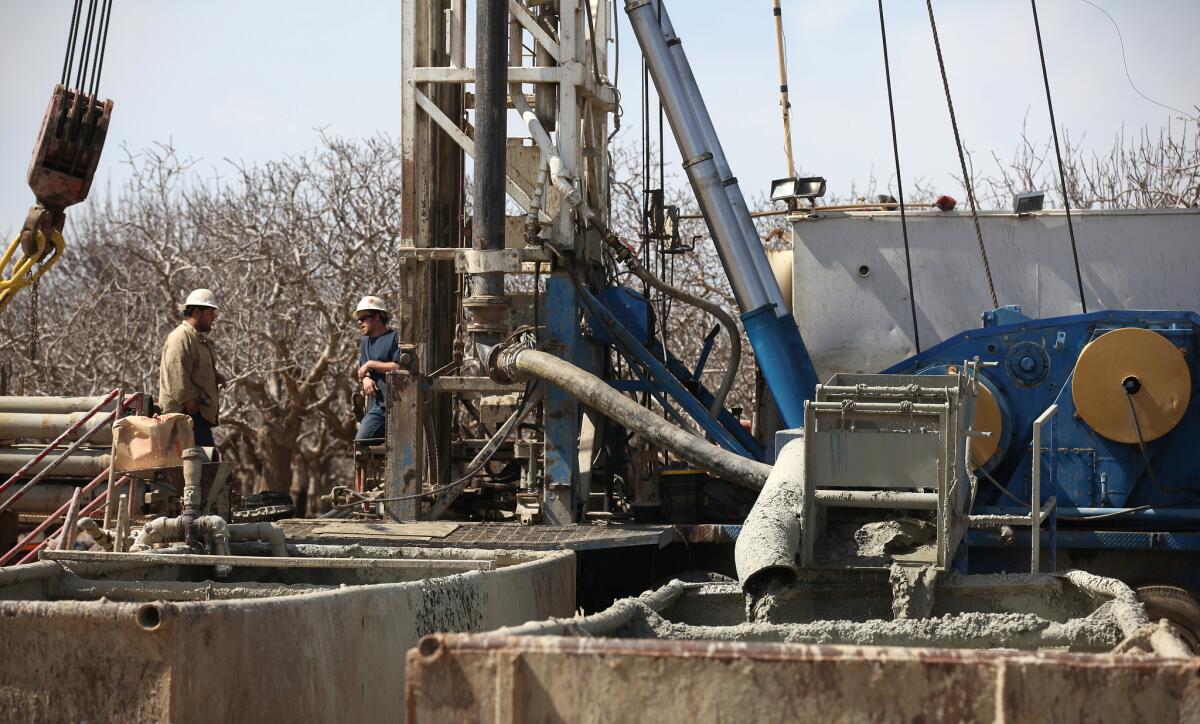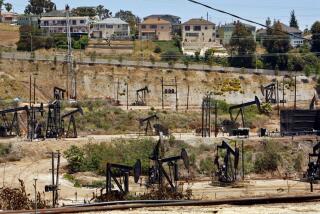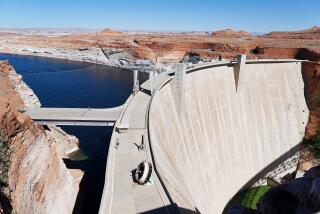Fracking poses risks to drinking water, EPA says, but hasn’t caused ‘systemic’ damage

Fluids from the fracking process flow into containment tanks at a oil well near Bakersfield. A new EPA study says that hydraulic fracturing poses risks for drinking water but that the harm is limited. Doubts remain about how comprehensive the study is, however.
Hydraulic fracturing, which has transformed the U.S. into an international leader in oil and gas production but stirred deep concerns about its risks to the environment, has not caused “systemic” damage to drinking water but does pose risks, the federal government concluded Thursday after a detailed, four-year review of the controversial drilling method.
The Environmental Protection Agency, in a draft report numbering more than 900 pages, said that while fracking operations “have not led to widespread, systemic impacts on drinking water resources, there are potential vulnerabilities in the water lifecycle that could impact drinking water.”
The study did find evidence of problems associated with the procedure, which involves injecting liquids at high pressure into underground formations to extract oil and gas. It cited specific instances in which well integrity and wastewater management related to fracking activities had affected drinking water resources, but it said these instances “were small compared to the large number of hydraulically fractured wells across the country.”
How comprehensive the report is remains in question. Thomas Burke, the EPA’s science advisor, called it “the most complete compilation of scientific data to date,” including more than 950 published papers, technical and scientific reports as well as input from parties with stakes in the issue. But the report itself emphasized the agency’s well-documented problems in gathering information, including the industry’s refusal to cooperate with some testing.
Limitations on data available to the agency, the report said, prevented a determination “with any certainty” of how frequently water supplies had been affected by fracking activities.
The agency said the relatively small number of cases of negative effects it had identified “could reflect a rarity of effects on drinking water resources, but may also be due to other limiting factors.”
Those factors, it said, could include insufficient data on the quality of drinking water resources both before and after fracking; the paucity of long-term studies; the presence of other sources of contamination, making it difficult to establish a definitive link to fracking; and “the inaccessiblity of some information on hydraulic fracturing.”
When the study was initially outlined in 2010, it was expected to include initial baseline testing of sites where wells were to be drilled, then follow up with testing during and after fracking operations were conducted, according to Geoffrey Thyne, a Wyoming geologist who served on the initial scientific advisory board for the study in 2010 and 2011. Those plans were halted after industry declined to cooperate.
“I’m very disappointed to see that we did not have any prospective studies as part of this effort, and I think it undermines the strengths of the conclusions,” Thyne said in an interview Thursday.
The EPA said it lacked complete information on “the number and location of hydraulically fractured wells, the location of drinking water resources, and information on changes in industry practices.” It noted that it relied on an industry-funded voluntary reporting source, FracFocus, to study chemicals used in fracking, and the information was limited.
“Well operators claimed at least one chemical as confidential at more than 70% of wells reported to FracFocus and analyzed by the EPA,” the report said. “The identity of these chemicals, and other chemicals in produced water, are needed to understand their properties and would also help inform what chemicals to test for to establish baseline conditions and to test for in the event of a suspected drinking water impact.”
Concerns about water contamination from fracking have been particularly high in California, where the state agency that regulates the oil industry has been in disarray.
Last summer, agency officials admitted that for years they had inadvertently allowed companies to inject wastewater from fracking and other oil production operations into hundreds of disposal wells in protected aquifers, a violation of federal law. As of March, the agency had shut down 23 injection wells that are in aquifers not approved for waste disposal. New state reporting requirements have prompted disclosures by some drillers that water involved in fracking has contained levels of benzene that in some cases were thousands of times above federal and state standards for safe drinking water.
The EPA report noted many ways water can be affected by fracking, whether by spills, cracks in equipment intended to seal wells, disposal of wastewater, contamination from chemicals or lowering groundwater levels. It cited a Texas study that found “excessive drawdown” of local groundwater in a small proportion — about 6% — of the Eagle Ford Shale formation underlying much of south Texas was related to water used for fracking.
The report also cited limited data it gathered from FracFocus on 453 chemicals used in fracking that it said could “persist in the environment as long-term contaminants.” It noted that “a large proportion of most hydraulic fracturing chemicals tend to remain in water.”
The oil and gas industry embraced the report.
“After more than five years and millions of dollars, the evidence gathered by EPA confirms what the agency has already acknowledged and what the oil and gas industry has known,” Erik Milito, director of the American Petroleum Institute’s Upstream Group, said in a statement on the institute’s website. “Hydraulic fracturing is being done safely under the strong environmental stewardship of state regulators and industry best practices.”
Amy Mall, a senior policy analyst for the Natural Resources Defense Council, disputed that assessment. “This study doesn’t show that it’s being done safely,” she said. “It concludes that fracking has led to contamination of drinking water sources, which to me is not safe.”
Mark Brownstein, vice president for the climate and energy program at the Environmental Defense Fund, said fracking’s biggest risks may be long-term ones.
“The process of fracking itself is one risk factor,” he said. “But ... ongoing physical integrity of the wells and handling the millions of gallons of wastewater coming back to the surface after fracking ... are even bigger challenges.”
In less than a decade, fracking has eased concerns about the nation’s long-term energy supply even as it has raised new concerns about fracking’s potential to cause earthquakes, threaten underground water resources and contribute to climate change.
More to Read
Sign up for Essential California
The most important California stories and recommendations in your inbox every morning.
You may occasionally receive promotional content from the Los Angeles Times.











